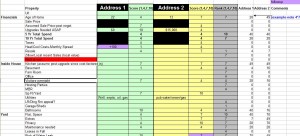My wife and I have been mulling over a move for some time now and we’ve finally reached the point where we put our house up for sale and we’re looking at homes in another area. The primary driver is to move to a better school district (public school, not private school), but there are also some benefits from a work commute, family, friend, desired location standpoint as well. We had also mulled over whether it was worthwhile to put in a pool and the overwhelming consensus was that we’re better off just buying a place with a pool if we really wanted one and were considering moving as opposed to putting one in ourselves given the payback, the cost, the hassle, the scams from installers, etc. so both places have relatively new pools installed. That being said, there are tons of different criteria by which to assess which of the candidates we should target.
The asking price is often the first thing people hone in on, but what I found through my assessment was that it’s just a small piece of the puzzle. I actually broke the financials down into several sections and then estimated a total 5 year cost and 10 year cost to put the true financials into perspective. Why?
Of the two top homes we’re interested in, one is going for about $25,000 less. However, the house is 22 years old vs. 13 for the more expensive one. Well, the 22 year old house is surely going to need a new roof in the next 5-10 years, right? Additionally, when looking at heating/cooling costs, I’m estimating that the older home will cost about $1000 more per year in utility bills. That’s because the older home has oil heat and I make the presumption that the home is not as “tight” whereas the newer home runs on gas for oven, dryer, heat and being newer, it’s likely more energy efficient. Taxes are about the same but I’ve factored in other things like upgrades my wife will inevitably want to do to the kitchen appliances, painting, etc. Essentially, I tried to weigh ALL the known costs over these two periods as opposed to just focusing on asking price.
Result?
As it turns out, the spread between the two homes over 5 year and 10 year periods is only a couple thousand dollars, so virtually nothing given the inherent slack in my estimates, i.e. these differences are not statistically significant. Therefore, I’m ruling out asking price as a criteria in choosing between the two.
What Matters Aside from Price?
Well, that’s where I started to focus on what’s important to us. Since we’re leaving a house that backs to woods now and we enjoy some privacy and our kids love bugs and exploring, we definitely wanted a place with a similar backdrop rather than a house in the back yard. I also want at least a decent amount of space to be able to kick around a soccer ball and hit a baseball to my kids. Not acres, but what we have now is a sloped yard and it’s not very conducive to these things. Additionally, things like curb appeal, what the neighborhood seems like, is it a “walkable” neighborhood, any noise from local major roads, etc. and the list goes on.
How’s This Selection Tool Work?
With these criteria in mind, here’s where the nerd kicked in. Since I used to run FMEAs, HAZOPs, Supplier Selection grids and other tools that tried to put a quantitative tilt on qualitative measures, I was used to putting weightings and scores to such measures. So, I developed this spreadsheet to score these various criteria as 1,4,7,10 with 10 being the best and then I weighted these items by 1,4,7,10 as well to reflect relative importance. For instance, resale potential isn’t as important as the 10 year total cost as an example – we don’t plan on moving again soon after this!
I’ve scrubbed some info so as to not share unnecessary detail about our finances, but you get the picture. By looking at the product of the (score X weight)=Total, each row gets a relative number and each property is then added at the bottom. Since I’ve been able to eliminate asking price (or assumed final sale price as I assumed I could get 10K off asking price for either through negotiation), this allows us to focus on the home aspects in particular. So far, one property’s clearly winning out over the other, but we do need to walk through each again and take inventory of what we like, dislike and things we still need to do.
Anyway, you might think this tool’s kind of corny or over-engineered, but having used it in choosing between various options at work and in other major decisions in my personal life, I thought you might find something like this to be useful – it was for my finances. (Also, I’m hoping I can use it to justify the property I like over the one my wife likes haha…)
What do you think?


{ 0 comments… add one now }
{ 1 trackback }